Our Stellar Neighborhood
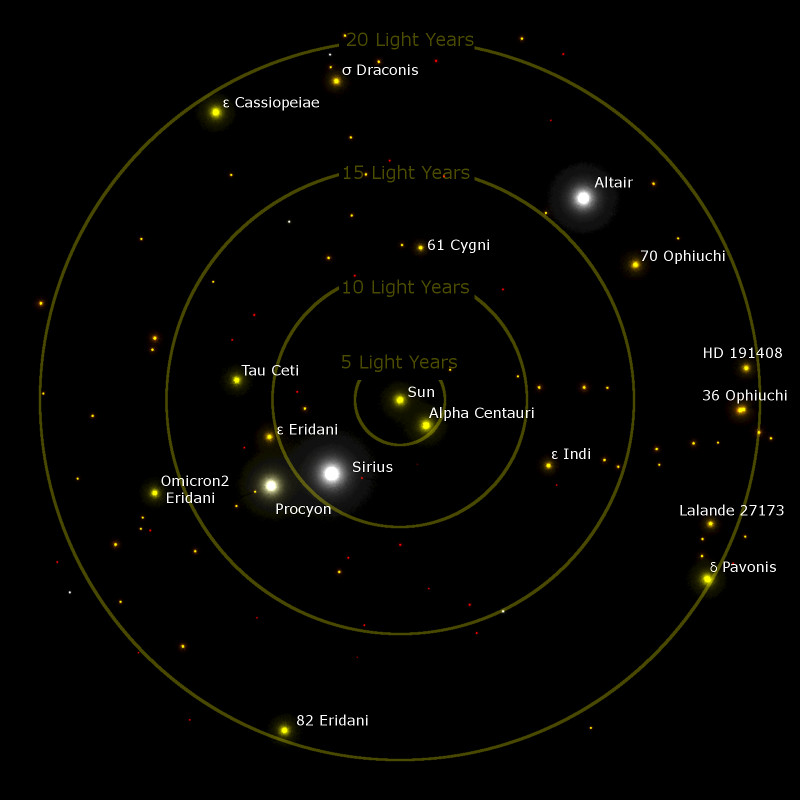
Our Stellar Neighborhood out to approximately 21 Lightyears. Stars and their relative brightness as well as color, are shown approximately, with the most significant stars labeled. The projection here is a little unusual, in that I have collapsed 3D space into a 2D disk, but in a way that preserves the true spatial distribution of the stars ( @lordneroo feel free to ask questions!)
One of the things I remember growing up within the 1970s, in the midst of the space race, was the prospect that we would one day travel to the stars. Engineers were already thinking of ways of achieving significant fractions of the speed of light necessary to get to the nearest stars. Project Daedalus was one such design.
Although, even half a century later, we are still a long way from achieving interstellar travel it is likely only a matter of time. Naturally, the nearest stars will be our first step when we finally make that step. In this article, I will explore our local stellar neighborhood out to 21 light years which is what we have pretty good data on and is reachable should 20-30% light speed become possible.
In our stellar neighborhood, there are around 150 known stars and a growing list of planets. For Sci-Fi movie buffs the good news is Alpha Centauri (Avatar - 2009) and Altair (Forbidden Planet - 1956) are real stars and are on our list. But thankfully there is no LV-426 (Alien/Prometheus)!
Sirius - The local Powerhouse
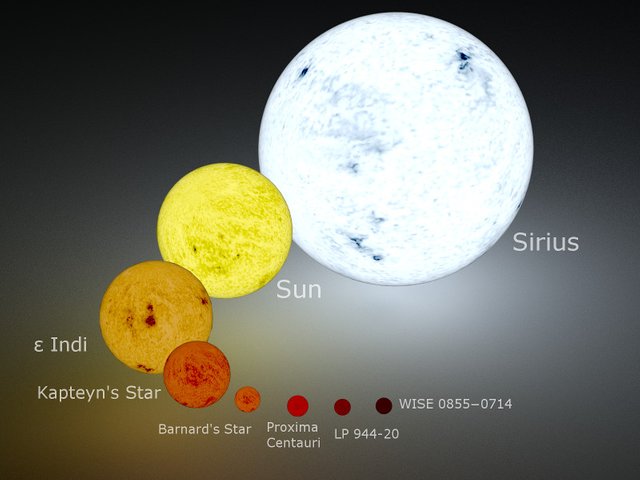
Size, brightness and color comparison of a number of the local stars including Sirius and the Sun. Here the brightest star Sirius is shown all the way through to cold Brown Dwarf star WISE 0855-0714
What better place to start our exploration than with the local powerhouse, the star Sirius. Of the 150 local stars, Sirius is the alpha star with 22x the luminosity of the sun. From earth, it is the brightest nighttime star. It is also sometimes called the "Dog Star" because it is the main star of the constellation of Canis Major.
Sirius also has a companion white dwarf star (Sirius B) that can be seen through a good amateur telescope if the atmosphere is sufficiently steady. Below is one of my better photo's of Sirius and it's white dwarf companion.
The white dwarf star is known as a degenerate star as it has exhausted it's nuclear fusion supply so that it can no longer support the mass of the star itself. Sirius B has about the same mass as the sun but has collapsed to a volume less than a millionth of the sun. There are a total of 8 white dwarf stars in the stellar neighborhood, however, to see any of them requires a telescope. Star Omicron2 Eridani B is perhaps the easiest white dwarf star to see.

Sirius and it's white dwarf companion (small star above the main star) is visible in the image made with a 30cm reflector and BW video camera. Note the airy disk diffraction ring around the fainter star.
There are also two other nearby luminous stars called Altair and Procyon, which are much brighter than the sun. These stars also appear as bright stars in our night sky and can be seen easily with the naked eye on any clear night, even from the city.
The Sun, Sunlike stars and Life
For us, the sun is the most important star, but sun-like stars are interesting from the point of view that they might have life-bearing planets. Our sun is a main sequence star of spectral classification G which has some important implications such as it has stable energy output as well a lifetime of approximately 10 billion years. Stars like Sirius have lifetimes under a billion years, which is probably insufficient time for life to develop.
In our vicinity, there are a number of sunlike stars, and below is some information on those stars. The data includes mass and size (relative to the sun), the exterior temperature in Celcius, age in billions of years, number of known planets and the likelihood of finding a planet with the right conditions for life to evolve.
| Star | Mass | Size | Temp C | Age | Planets | Life? |
|---|---|---|---|---|---|---|
| Sun | 1.0 | 1.00 | 5500 | 4.6 | 8 | Yes |
| Alpha Centauri A | 1.10 | 1.27 | 5460 | 4.4 | ? | Unlikely |
| Eta Cassiopeiae A | 0.97 | 1.01 | 5900 | 5.4 | ? | Unlikely |
| Delta Pavonis | 1.00 | 1.22 | 5230 | 7-9 | ? | Chance |
| 82 Eridani | 0.97 | 0.92 | 5200 | 6-12 | >3 | Chance |
| 70 Ophiuchi A | 0.92 | 1.02 | 4800 | 2 | ? | Unlikely |
| Tau Ceti | 0.92 | 0.81 | 5150 | 6 | 5? | Chance |
| Sigma Draconis | 0.89 | 0.80 | 5000 | 3 | 1? | Chance |
The second star on this list is the fabled Alpha Centauri, whose primary star is very much like the sun. However, the presence of the second star makes it difficult for stable planet orbits to form.
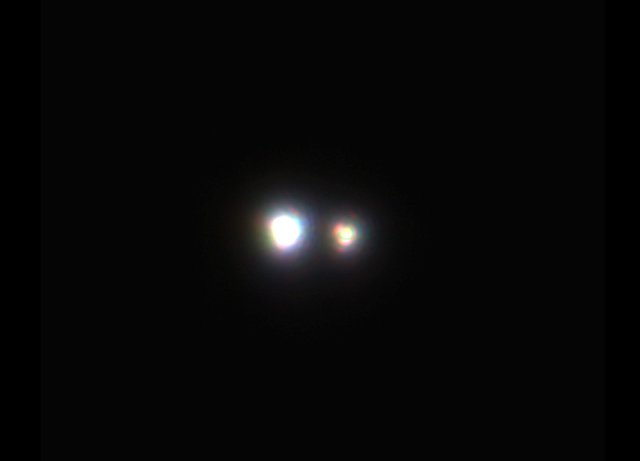
Alpha Centauri is actually 3 stars, the largest components A and B are visible in this image. Component A is very similar in brightness, mass, and temperature to our own sun. This image is from an article I posted earlier this year titled The Alpha Centauri Star System
In the table above some of the stars are marked as unlikely as harboring life-bearing planets. The reason for this is that there additional factors at play, including the following:
- High Metallicity - A star with high amounts of heavier elements such as Silicon and Iron are more likely to have formed with planets.
- Old - An older star system will have had more opportunity for life to form.
- Single Stars - Stars orbited by other stars can destabilize planetary orbits.
One of the above stars, Delta Pavonis, is considerably older than the sun and is now starting to reach the Helium fusing stage which will soon cause it to evolve into a Red Giant star. Therefore any intelligent life there might want to start prepping!
Red Dwarf Stars
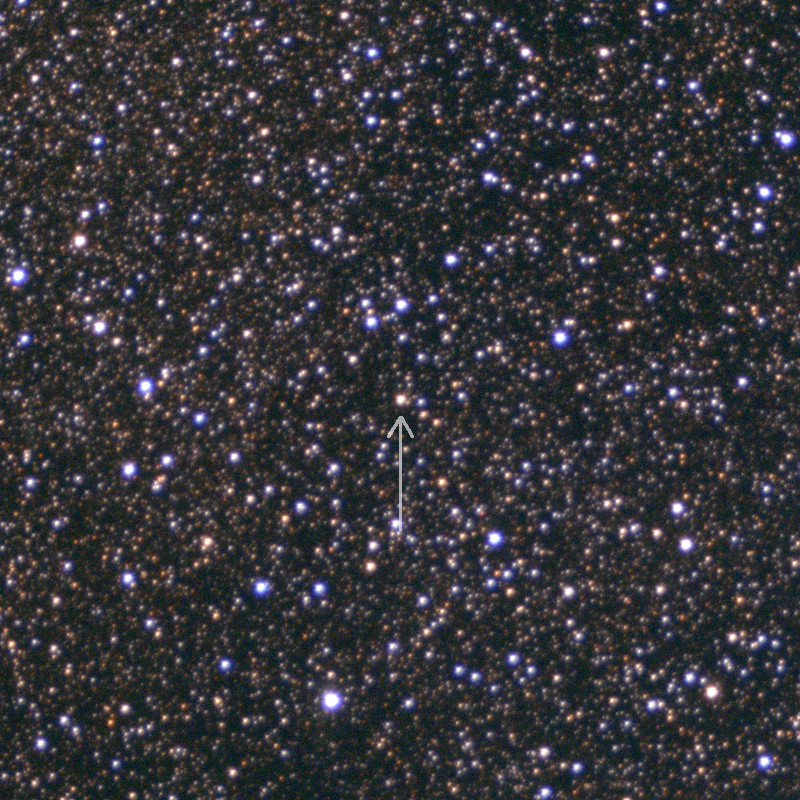
The red dwarf star Proxima Centauri is the C component of Alpha Centauri. This image is from an article I posted earlier this year titled The Alpha Centauri Star System
Red dwarf stars are by far the most numerous of all true stars. These stars, generally have between 8-50% of the suns mass but are still large enough to fuse Hydrogen into Helium. However, they are typically cooler than the sun at around 3000 Celcius at exterior and several orders of magnitude fainter.
In our stellar neighborhood out to 21 light years, nearly 100 of the 150 or so stars are classed as red dwarfs. Our nearest star Proxima Centauri is a red dwarf star. However, in spite being so numerous not one of them is bright enough to be seen with the naked eye.
Many red dwarf stars are known to possess planets. But there are some potential problems that could reduce the likelihood of life, such as:
- A number of red dwarfs are known to be flare stars, the star's output can increase several times for several minutes.
- Planets close enough to the star for sufficient warmth will likely be tidally locked to the star, meaning the atmosphere could be frozen out on the perpetually night facing side.
Brown Dwarf's
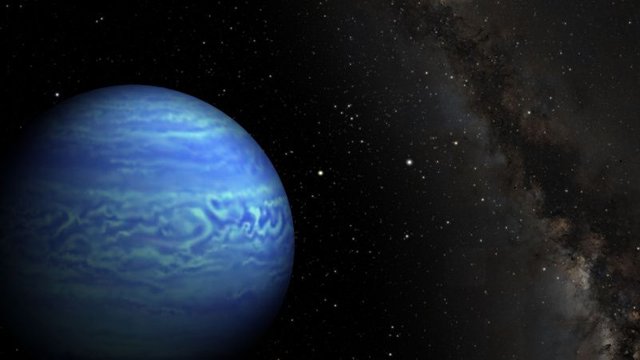
Artist impression of nearby brown dwarf WISE J085510.83-071442.5. It is believed to possess water vapor/ice clouds and has an exterior temperature below freezing point. Image Credit: NASA
Brown dwarfs are stars that have insufficient mass to support significant Hydrogen fusion. They emit almost all their light in infrared and can be very difficult to detect even with large sensitive telescopes.
Within 21 light-years some 30 brown dwarf's have been identified. However, it is likely many more will be found. One newly discovered brown dwarf, WISE J085510.83-071442.5, is 100 times less massive than the sun. Its output is so low, the exterior is below freezing and is believed to have water clouds.
Other identified brown dwarfs are warmer and brighter, for example, Luhman 16 a nearby star has an exterior temperature of 1000 degrees Celcius. If the sun was replaced with Luhman 16, it would look like a tiny bright red iridescent disk against a dark starry sky.
3D animation
Finally, this article gave me an opportunity to model the nearest stars in Blender 2.79. So here is an animation of flying around the sun from approximately 50 light years. Star colors and brightnesses are somewhat exaggerated for effect.
Can you identify some of the stars in this animation from the article above? As a hint the sun is the stationary yellow star, Alpha Centauri is the slightly brighter yellow star orbiting close in and Sirius is the Brightest star.
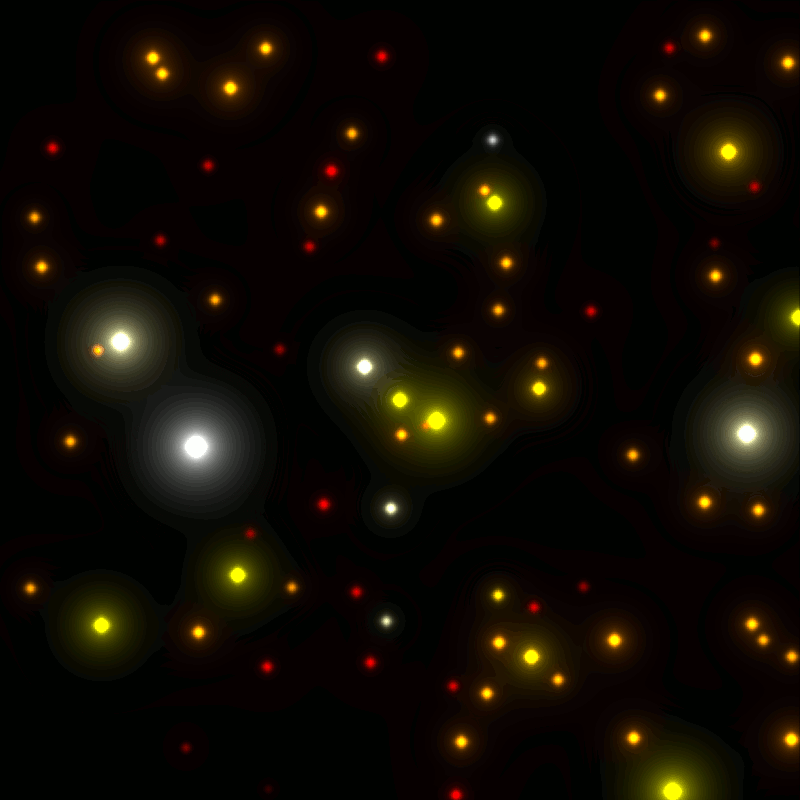
Orbiting from a distance of 50 lightyears. The sun is the stationary yellow star at the center, SIrius is the brightest white star. Can you identify any other stars?
Conclusions and Further Reading
I hope the above article gave you some insight into what interesting objects can be found in our local stellar neighborhood. For more information please consult the following references.
Finally, note all images and diagrams in this article are the authors unless otherwise noted. Please feel free to use them so long as you credit me (i.e. Image Credit:@terrylovejoy).

Very technical yet very informative. Thank you for the great post!
Thank you @bernardino !
Being A SteemStem Member
Hey @terrylovejoy! Just woke up! I was too busy yesterday so I took the time to read through your work today before commenting!
Thanks for the shout out by the way! Is that a rectangular conformal projection? I think it serves your blog's purpose perfectly fine. I also think you could have achieved a similar outcome by utilizing a cylindrical compromise projection! I really thought there were MANY more stars within 21 lightyears from Earth! Whoa!
I'm just too jealous you can take all those shots of stars and planets on your own! I wish I had such a telescope! Each and every time I read I feel like I have to buy a telescope like yours! It has to feel great spotting all those stars and planets in the night sky and taking a ''real time'' look. (I sure know it's not :P)
Didn't know Sirius had such a small lifespan! Makes sense considering its size! Those blogs of yours are truly inspiring.
Keep up the quality work!
I am not sure whether this a true conformal projection. It was computed as follows
X' = S . X
Y' = S . Y
Z' = 0
where S = R ^ 1.5, and R = sqrt ( X2 + Y2 + Z2) / sqrt (X2 + Y2)
Why power 1.5, well its because if I didn't stars would all appeared clustered around the periphery of the projection. This way the density of stars is preserved across the projection.
I see! Thanks for the detailed info! So you basically created your own projection. I really love this software you're using!
Yeh you can do virtually anything with the built-in Python scripting engine. I used Blender Python to read in the X,Y,Z coords from a file and did the above transformation.
Where did you get the X,Y,Z coords? Observations through some sort of software or available values somewhere on the net?
Actually, I took the list of X,Y,Z from my first reference. But I could have calculated them using Right Ascension, Declination and Distance from one the available catalogs which can be downloaded in column delimited formatted.
That reminds me, I need to learn Blender.
I remember from my telescoping days that one of my favourites objects was Albireo (400 ly away).
Usually every object in the viewfinder is some shade of white but for Albireo the contrast in colours between the two stars was always interesting.
Yes blender is cool...don't let the learning curve scare you off!
I am used to POV Ray so I am hoping Blender will be at least not harder than that.
terry, a good read! I got confused with a line though
Why do planets close to red dwarfs have to be tidally locked?
By the way, the Blender animation looks cool!
Thank you @anevolvedmonkey . Tidal locking occurs as a result of torque being applied to the planet. Remember the gravitation force itself causes a bulge, which effectively becomes the handle in which the torque can be applied.
Now a typical red dwarf will have 1/10000 th the output of the sun, so to compensate for this output we would have to move the planet 100 times closer to the star (square law). This also means the tidal forces also increase 100 times. Now the mass of the red dwarf is smaller, so the tidal forces won't be 100x more, but more like 10-20x. But this is still a lot of extra tidal force.
Thanks for clearing this. I had the same issue. I always have problem assimilating astronomical topics. I just feel they are beyond me. Lol
I was hoping I made sense in my last response!
Yeah, you did
Brilliant as always Terry, and no is the short answer to identifying stars in your diagram. Maybe I can point my trusty phone app at it? Hmm... 🤔
I didn't think anyone would so don't worry. I just wanted to add that animation because I thought it kind of looked cool and it took too long to generate for it not to be added to the post :) Anyway thank you once again @choogirl !
It was cool. I liked it.
Another awesome post by the big man himself...Growing up as a kid was fun sitting outside under the bright moon and the smiling starts...I relish every moment spent then...
Thanks for bringing back the memory.
Do I want to travel to the star? Maybe not, might freak out :)
Enjoyed the article a lot. A question, are brown dwarfs always classified as stars? What is the defining feature of a star? A certain size or having some degree of hydrogen fusion?
That is a good question and I think there is no well-defined line between the largest planets and smallest stars. It is suspected that some fusion processes are taking place with deuterium (a rare isotope of Hydrogen) but these do not generate enough energy to heat the brown dwarf to anything but a relatively dim glowing red object to the naked eye.
Thanks for the answer. A lot of strange and interesting objects out there in the universe, looking forward to the next article
Nice stuff! Love the detail explanations and nice animation too! Have you heard of a book series called the "Three Body Problem"? It is about Earth's contact with a civilisation from Alpha Centauri who spend millennia trying to survive the harsh condition brought in by the triple star system. A science fiction, but is a very interesting read.
Thank's mate I'll have to look that one up, sounds like an interesting book. Apparently, there are some stable orbit configurations for planets with Alpha A and B Centauri, we shall see as we get better telescopes in the future.
Excellent, this is really a great post. a detailed explanation, I really enjoy it
good jobs @terrylovejoy